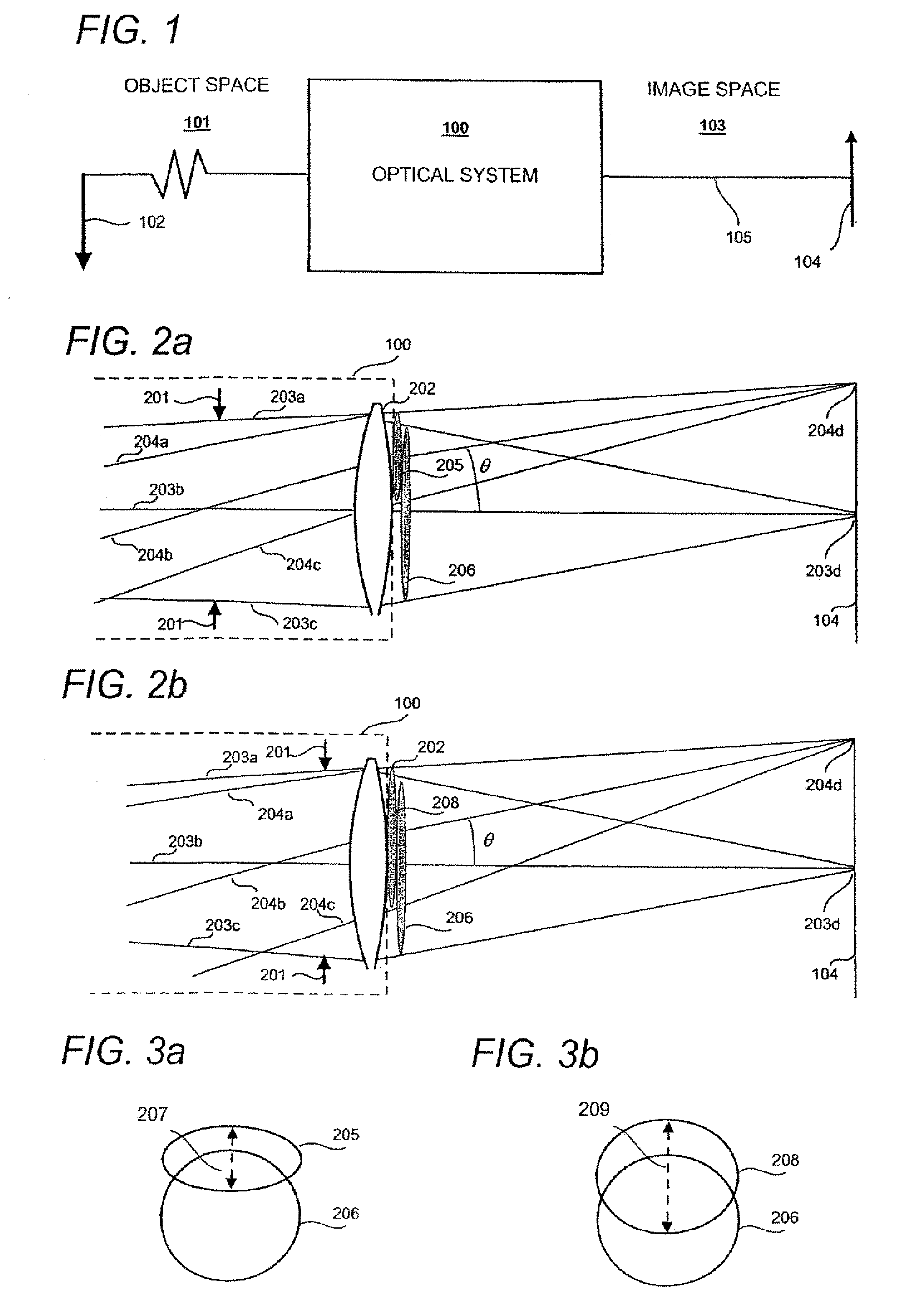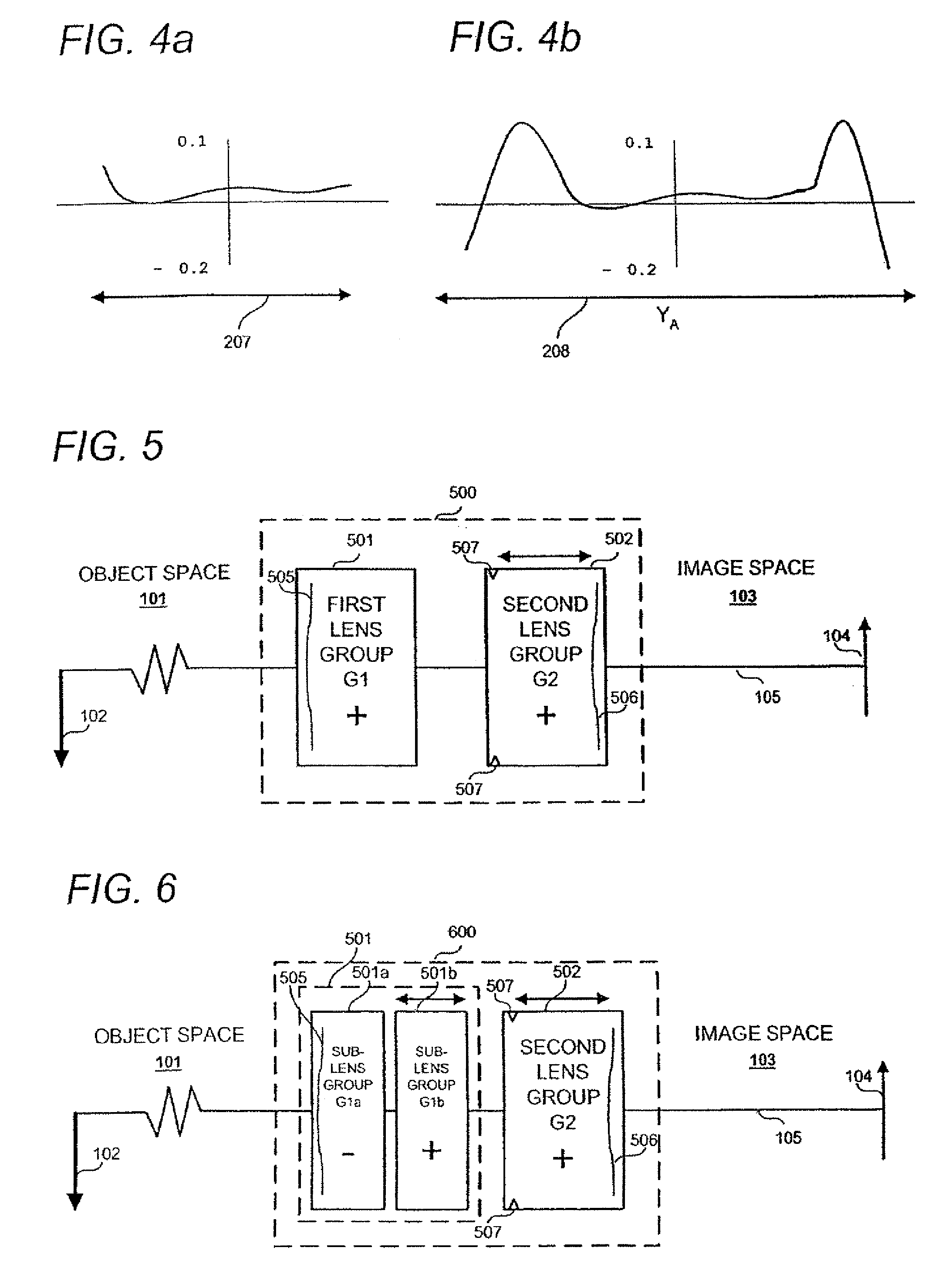Objective lens system
a fixed focal length, objective technology, applied in the direction of optics, lenses, instruments, etc., can solve the problems of large size of zoom lenses, poor image quality, and larger size of equivalent aperture prime lenses, and achieve high relative illumination and high contrast
- Summary
- Abstract
- Description
- Claims
- Application Information
AI Technical Summary
Benefits of technology
Problems solved by technology
Method used
Image
Examples
first embodiment
[0052]A preferred embodiment of the present invention will now be described by way of design examples with reference to FIGS. 7 and 8a to 8c, corresponding Table 1 and the optical prescription data contained therein which is extracted from data produced by CODEV V® optical design software that is commercially available from Optical Research Associates, Inc., Pasadena, Calif., U.S.A. All of the data contained herein is given at a temperature of 25° C. (77° F.) and standard atmospheric pressure (769 mm Hg).
[0053]Turning now to FIG. 7, in a preferred embodiment of the present invention a wide-angle prime lens 700 with a fixed focal length of substantially 18 mm is shown that comprises a plurality of lens elements. The lens 700 is configured in accordance with the lens group power configuration 600 illustrated in FIG. 6 and already described above. Each lens element is identified by a label comprising the letter ‘L’ and a numeral ranging from 1 through 19. The shape and configuration of...
second embodiment
[0080]Turning now to FIG. 12, in a second embodiment of the present invention a medium-angle prime lens with a fixed focal length of substantially 40 mm is shown comprising a number of lens elements. The lens 1200 utilises the lens group power configuration illustrated in FIG. 5 and described above. Each lens element is again identified by a label comprising the letter ‘L’ and a numeral 1 through 16. The shape and configuration of each lens element being as depicted while the specific radius of each lens surface is given in Table 3, each surface again being identified by a label comprising the letter ‘S’ followed by a numeral. The surfaces are numbered in sequence starting at S1 for the surface nearest the object side of the lens and ending S29 for the last optical surface at the rear of the lens. While only the lens elements L 1 to L16 are shown in FIG. 11 it is to be understood that conventional mechanical devices and mechanisms are provided (but not shown) for supporting the lens...
third embodiment
[0098]Turning now to FIG. 15, in a third embodiment of the present invention 1500 a narrow-angle prime lens with a fixed focal length of substantially 100 mm is shown that comprises a plurality of lens elements. The lens 1500 is configured in accordance with the lens group configuration illustrated in FIG. 6 and described above. Each lens element is once again identified by a label comprising the letter ‘L’ and a numeral from 1 through 14. The shape and configuration of each lens element being as depicted while the specific radius of each lens surface is given in Table 5, each surface once again being identified by a label comprising the letter ‘S’ followed by a numeral. The surfaces are numbered in sequence starting at S1 for the surface nearest the object side of the lens and ending S26 for the last optical surface at the rear of the lens. As with the previous embodiments, while only the lens elements are shown in FIG. 15, it is to be again understood that conventional mechanical ...
PUM
 Login to View More
Login to View More Abstract
Description
Claims
Application Information
 Login to View More
Login to View More - R&D
- Intellectual Property
- Life Sciences
- Materials
- Tech Scout
- Unparalleled Data Quality
- Higher Quality Content
- 60% Fewer Hallucinations
Browse by: Latest US Patents, China's latest patents, Technical Efficacy Thesaurus, Application Domain, Technology Topic, Popular Technical Reports.
© 2025 PatSnap. All rights reserved.Legal|Privacy policy|Modern Slavery Act Transparency Statement|Sitemap|About US| Contact US: help@patsnap.com



